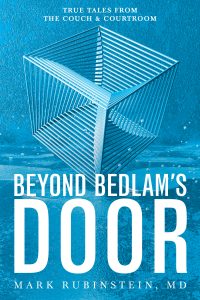Review: Beyond Bedlam’s Door : True Tales from the Couch and Courtroom by Mark Rubinstein
Posted by: Tim Gebhart 19 hours ago in Book Reviews, Books, Memoir, Non-Fiction 0 Comments
Case studies are a longstanding teaching and continuing education vehicle. In the last two decades, they’ve emerged from the halls of medical, business and other schools to bookstore popular nonfiction sections and best selling lists. The popularity of books by neurologist  Oliver Sacks contributed to an avalanche of such books, the problem being that few matched his skills. Mark Rubinstein deftly avoids the many pitfalls of the genre in Beyond Bedlam’s Door: True Tales from the Couch and Courtroom, his second book of vignettes from his four decades as a psychiatrist.
Oliver Sacks contributed to an avalanche of such books, the problem being that few matched his skills. Mark Rubinstein deftly avoids the many pitfalls of the genre in Beyond Bedlam’s Door: True Tales from the Couch and Courtroom, his second book of vignettes from his four decades as a psychiatrist.
It follows the same format as his first such book, last year’s Bedlam’s Door:True Tales of Madness and Hope. Both tell the stories of a variety of patients, each followed by an “Afterword” addressing the particular issues or conditions at play. In this way Rubinstein seeks to not only make each patient’s story personal and relatable but to explain psychiatric conditions and their ramifications for the individual, their family and society.
Bedlam’s Door, a term used when an emergency room becomes “a revolving carousel of psychosis,” portrays patients Rubinstein encountered at various medical facilities. Beyond Bedlam’s Door is just what its title and subtitle suggest: accounts of his work outside the institutional setting, whether treating someone in private practice or as a forensic psychiatrist.
Rubinstein uses an almost parable-like approach in the 21 stories in Beyond Bedlam’s Door to illustrate the diversity of psychiatric issues and what psychiatrists do. Among the topics he explores are professional malpractice, the difficulty of treating adolescents, the importance of doctor-patient boundaries, and the difference between crossing those boundaries and violating them.
His method of recounting patient histories in the form of reconstructed conversations provides a foundation by which Beyond Bedlam’s Door intelligibly explains and demystifies a variety of mental health issues, from panic attacks to depression to post-traumatic stress disorder. More important, Rubinstein shows that the stories of his patients really weave “a tapestry of human thinking, feeling, and behavior” in which “we see reflections of ourselves.”
Rubinstein’s background as a forensic psychiatrist — a psychiatrist who works with attorneys, courts, or other parties involved in actual or potential litigation — also allows him to provide an inside view of the interplay between law and psychiatry. He furnishes easy to understand explanations of various psychiatric issues in the law.
For example, Beyond Bedlam’s Door concisely and coherently spells out the recurring question in workers’ compensation cases of “physical-mental” and “mental-mental” injuries. Likewise, he describes the job of an expert witness, the so-called “gunslinger” expert and how forensic evaluations differ from evaluating a patient for treatment.
Beyond Bedlam’s Door sporadically repeats information from Rubinstein’s prior book, at times verbatim. To be fair, that likely is simply the nature of the beast when it comes to describing and explaining mental health conditions. Some may also be put off by the fact that while the reconstructed dialogue makes the book more literary, it can also feel artificial. That said, Beyond Bedlam’s Door is a top-notch look at the reality and relevance of psychiatry in today’s America.





Leave a Reply
You must be logged in to post a comment.